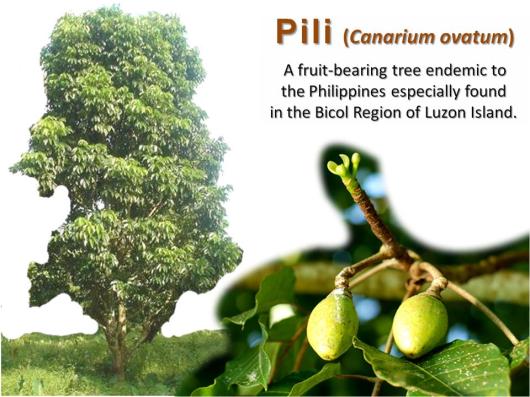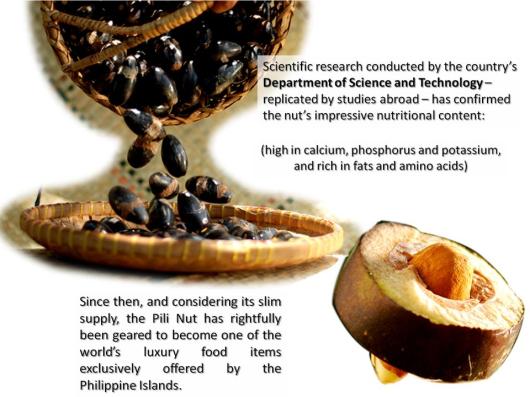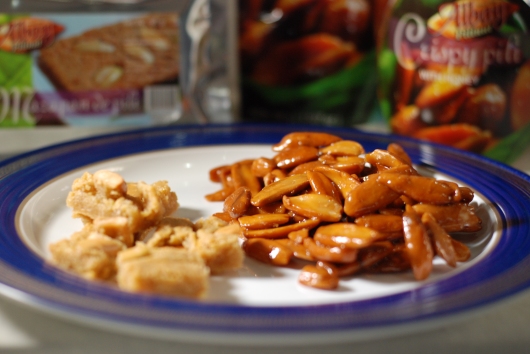I. About the Product (Pili)
The Pili Nut has the flavor of pumpkin seed when raw, and takes on an entirely different identity when roasted. It is soft yet crisp, with an easy crunch that surprisingly melts in your mouth, making it a favorite snack food among Filipinos. The same delighted acceptance is true even in other countries that have already obtained the nut as an imported staple.
With global tastes now putting a premium on much healthier edibles, and with the insistent clamor for new snacking alternatives, the world market is more than ready to welcome the Pili Nut among its gamut of highly-valued food products.
II. About the Philippines and the Bicol Region
The Philippines is a 100-million-strong agri-marine nation enjoying the manifold gifts of its archipelagic ecosystems. Given this richness and diversity of natural resources, the Filipino foodscape is characterized by very unique yet abundantly available products and delicacies, a number of which are not found elsewhere in the planet.
The Pili Nut can be spotted in bushes across tropical Asia and other Pacific islands, but the ones grown in the Bicol Region, southeastern end of the Philippine island of Luzon, are acknowledged as the best-tasting yet. And why ever not; the region is where the best variables for growing Pili converge.
Home to at least five active volcanoes – one of which is the perfect-coned and world-admired Mayon Volcano – Bicol’s land is a fecund mix of volcanic soil and generous rainfall. That typhoons regularly pass through the region does not even pose a problem to Bicolano Pili growers, as the Pili Tree is known as a “stress tree”, that is, the more it is shaken and beaten by storms, the more it blooms and bears better fruit.
The Philippines is the only country capable of the commercial production and processing of Pili-based food and by-products, with Bicol supplying 80% of the total output volume.
III. About the Pili industry
Most Pili farmers attest to the fact that the Pili is a low-maintenance crop. It only needs pruning from time to time, requiring minimal fertilizers, or even none at all. Native species that grow as tall as coconut trees would yield its first fruits after five years; grafted trees, shorter therefore safer for barefooted harvesters who climb them, start bearing fruit in three years.
Workers in the industry are predominantly female (58%); they handle the cleaning, cooking, and packing stages in processing Pili Nuts. The male workers (42%) are mainly in charge of harvest, delivery, and de-shelling, the last being an anecdote in itself.
De-shelling a Pili Nut is an epic case of Man versus Machine, where Man refreshingly wins. Pili deshelling machines are not quite successful as they do crush the extremely hard, bony shell, but unfortunately tend to crush the precious kernel as well, in statistics too high for commercial viability.
Retrieving a perfect Pili kernel requires precision only human hands can deliver; this is easily due to the centuries-old tradition of Pili-cracking, enough practice to beat any machine. The Bicolanos call the process pagtilad – cracking the tough nut using a bolo, with unbelievably rhythmic, graceful and accurate whacking. A paratilad expert could easily slice through the thick, hardwood-esque Pili shells, and finish 100 kilograms in a day’s work.
The Pili Nut and its by-products have a steadily growing market in the United States, Middle East, Hongkong and China. The Philippines also exports Pili products to countries such as Japan, Germany, France, Great Britain, and in Hawaii.
IV. Applications of Pili Nut
The pulp of the Pili fruit is eaten as a vegetable. Blanched in hot water for about three minutes, it is perfect for salads, or simply dipped in fish sauce for that tangy kick.
But the most important part of the Pili Nut is its kernel. With its testa stripped off, it is a slender, yellowish-white core. The kernel is the raw material used in various recipes.

 Enjoying a significant share of the foreign food market are Pili sweets, pastries, and exotically-flavoured variants. Some examples are
Enjoying a significant share of the foreign food market are Pili sweets, pastries, and exotically-flavoured variants. Some examples are
· Crispy Pili, with a very thin sugar coat
· Honey-glazed Pili
· Pili with Sea salt
· Plain roasted Pili
· Mazapan de Pili, tarts, cakes, etc.
The kernel and the pulp are excellent sources of oil, used for baking, cooking or cuisine.The Pili tree sap, known around the world as the Manila Elemi, has a cool, zesty scent that is favoured for perfumes and aromatherapy oils.
The tree’s wood, meanwhile, is carved as furniture or home décor.
And the legendary hard shell, formerly only used as fuel, is now being transformed into nature-inspired fashion accessories, such as necklaces, earrings and bracelets.
The Philippines is proud to share its beloved “jewel” to the other cultures of the world and begin by launching this nutritional dynamo in the United States at the “Memphis in May” Festival. With other trade promotion events to follow, including, the Summer Fancy Food Show in Washington D.C. in June and the World Fair in Seattle Washington in the fall of this year, the goal is to build an expanded and common recognition of a Philippine brand, the Chosen Pili as a shining star from the Philippines just as the Macadamia nut is commonly branded to the state of Hawaii.
The Bicol Region’s OK Bikol Association and the DTI-Region 5 have conglomerated a sustainable alliance and together, partnered with the Philippine Embassy through Ambassador Jose L. Cuisia Jr. and the Philippine Trade and Investment Centers in Washington D.C., New York, Chicago, San Francisco and Los Angeles, as well as Exclusive Foods International (EFI), to bring the Pili Nut as well as other Philippine products to your local and national stores in the United States Market place for retail and food service industries.
Press Office, Embassy of the Philippines
1600 Massachusetts Ave NW | Washington, DC 20036
T: 202-467-9432 | F: 202-467-9417































Comments
Alright!
Muchas gracias, Jenny.
Your welcome Chito 🙂
naatasan po ako humawak ng pili development project sa province of Cam. Norte, under Provincial Agriculturist Office. Please PM/text me po re; some updates regarding chosen pili… 09178792868 / salvaneraces@yahoo.com
Please contact our Pili Nut account officer, Ms. Shierley Serrano, 480-5719.
Hi, I’d like to ask on where I can get a mechanical pili nut cracker? Thank you
Try to inquire from DOST. I think they have such cracker; though pili nut processors say manual cracking is more efficient than machine.
I see.. Thank you.. 🙂
I’m sourcing for pili sap grade A (cleaned) to be imported as a raw material. As an alternative, I am also looking for pili sap oil or elemi oil. Any help/info is highly appreciated.
Hi Vinia,
Thank you for your interest in pili.
May I refer you to our client with whom you can negotiate
re supply: http://okbikol.wordpress.com/okb-trade-fair-2012/featured-smes/manay-fes-pili-products/
san po available makabili nung mga sample photos ng packed pili nuts..thanks
You can download sample photos from http://www.okbikol.wordpress.com
Dennis, please see http://www.okbikol.wordpress.com for sample photos.
Hi, where could I buy raw/fresh pili fruit?
Hi Nico,
Thank you for your interest on the pili nut.
Try this link for possible supply:
This web site really has all the info I wanted concerning this
subject and didn’t know who to ask.
Thanks Charlene.
We’re glad to be of help.
Hi Admin, Our family back in Calbayog City, Samar owns six agricultural lands planted with coconut trees. Although the coconut lands are scattered, they measure between 1.5 to 3 hectares each.We are interested in developing at least one of our coconut lands (whichever is deemed most suitable) into Pili Farm.
You can contact DA for assistance in Pili production/ farming.
Hello sir/ma’am,
I would like to become a distributor of your product here in Benguet, another tourist spot in the Philippines.
Hi Zaldy, you can contact any of our producers at http://www.okbikol.wordpress.com for possible business tie-ups and ventures.
hi, mero po ba kayong driver seat cover na made of pili shell? yong ginagamit sa mga driver sa kanilang upuan na karaniwan made of bamboo, etc.
Jerson, right now wala pa production ng driver seat cover made of pili. We can suggest to our producers to consider making the product.
I want to buy Pili nuts do you have online store
Please contact our supplier directly at jempastries2@yahoo.com
Trackbacks
[…] more here: Pili Nut is launched in the United States in … – TRADE WINDS BICOL […]
… [Trackback]…
[…] Read More Infos here: tradewindsbicol.wordpress.com/2012/05/10/pili-nut-is-launched-in-the-united-states-in-memphis-in-may/ […]…
[…] Chosen Pili Products and Companies Chosen Pili: Regional Brand for Bicol pili and other food products […]
[…] Did you know that the pili tree (Canarium ovatum) is a sustainable, low-maintenance and stress-resistant tree? Pili is indigenous in the Bicol region where active volcanoes and rainfall abound. The more the pili tree is shaken and beaten by storms, the more it blooms and bears better fruit more, according to the Department of Trade and Industry-Bicol Tradewinds (here). […]
[…] Via tradewindsbicol […]